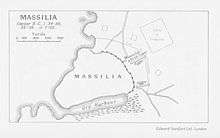Siege of Massilia
| ||||||||||||||||||||||||||||||
The Siege and naval Battle of Massilia was an episode of Caesar's civil war, fought in 49 BC.
Lucius Domitius Ahenobarbus had become proconsul of Gaul and was sent to gain control of Massilia (modern Marseille) in order to oppose Caesar. As Caesar marched to Hispania (en route to the Battle of Ilerda), the Massiliots closed their gates to him, having allied with Ahenobarbus and the Optimates. Roused by their hostile actions, he commenced a siege against Massilia, leaving the newly raised 17th, 18th, and 19th legions to conduct the siege. These were the same legions that would be wiped out at Teutoburg Forest 58 years later. He also placed Decimus Junius Brutus Albinus in charge of his fleet there.
After the siege had begun, Ahenobarbus arrived in Massilia to defend it against the Caesarian forces. In late June, Caesar's ships, although they were less skillfully built than those of the Massiliots and outnumbered, were victorious in the ensuing naval battle.
Gaius Trebonius, Caesar's legatus, conducted the siege using a variety of siege machines including siege towers, a siege-ramp, and a "testudo-ram". Gaius Scribonius Curio, careless in adequately guarding the Sicilian Straits, allowed Lucius Nasidius to bring more ships to the aid of Ahenobarbus. He fought a second naval battle with Decimus Brutus in early September, but withdrew defeated and sailed for Hispania.
Caesar built a stationary tower, 30 ft. square and six stories in height, under the very walls of the city and in face of a rain of missiles from its engines. The walls of the tower were of brickwork 5 ft. thick. When the lowest storey was built it was covered with a solid fireproof roof which was not secured to the walls but rested upon them like a lid. The eaves projected considerably, and from them screens were hung on all sides, covering all the walls. By means of screws the whole canopy, roof and screens, was now raised to the height of one storiey and the workmen proceeded to build the walls of that storiey under its protection. This process was repeated in the same manner until the full height of the tower was attained.[1]
The Massiliots valiantly defended against the siege machines and works. They threw down burning pitch and pine-shavings and the Caesarians undermined the foundations of their city walls. At one point they seemed likely to surrender and declare a truce, but at night they cunningly destroyed the siege works in a gross violation of the treaty, according to Caesar's own account (Bellum Civile 2.14; alternatively, Dio 41.25.2 records that the Massiliots destroyed these works in response to a surprise attack by the Caesarian forces). The city's inhabitants were then near surrender.
At the final surrender of Massilia, Caesar showed his usual leniency and Lucius Ahenobarbus escaped to Thessaly in the only vessel that was able to escape from the Populares. Afterwards, Massilia was allowed to keep nominal autonomy, due to ancient ties of friendship and support of Rome, along with some territories while most of its empire was confiscated by Julius Caesar.
Trivia
- The siege is the setting for Last Seen in Massilia in the Roma Sub Rosa detective series by Steven Saylor.
References
- ↑ cesar: de Bello Civili, Book II, 8, 9.
